+Search query
-Structure paper
| Title | Structure of a CSMN-type PSII-LHCII supercomplex from the green alga . |
|---|---|
| Journal, issue, pages | Proc Natl Acad Sci U S A, Vol. 116, Issue 42, Page 21246-21255, Year 2019 |
| Publish date | Oct 15, 2019 |
 Authors Authors | Liangliang Shen / Zihui Huang / Shenghai Chang / Wenda Wang / Jingfen Wang / Tingyun Kuang / Guangye Han / Jian-Ren Shen / Xing Zhang /   |
| PubMed Abstract | Photosystem II (PSII) in the thylakoid membranes of plants, algae, and cyanobacteria catalyzes light-induced oxidation of water by which light energy is converted to chemical energy and molecular ...Photosystem II (PSII) in the thylakoid membranes of plants, algae, and cyanobacteria catalyzes light-induced oxidation of water by which light energy is converted to chemical energy and molecular oxygen is produced. In higher plants and most eukaryotic algae, the PSII core is surrounded by variable numbers of light-harvesting antenna complex II (LHCII), forming a PSII-LHCII supercomplex. In order to harvest energy efficiently at low-light-intensity conditions under water, a complete PSII-LHCII supercomplex (CSMN) of the green alga (Cr) contains more antenna subunits and pigments than the dominant PSII-LHCII supercomplex (CSM) of plants. The detailed structure and energy transfer pathway of the Cr-PSII-LHCII remain unknown. Here we report a cryoelectron microscopy structure of a complete, CSMN-type PSII-LHCII supercomplex from at 3.37-Å resolution. The results show that the Cr-CSMN supercomplex is organized as a dimer, with 3 LHCII trimers, 1 CP26, and 1 CP29 peripheral antenna subunits surrounding each PSII core. The N-LHCII trimer partially occupies the position of CP24, which is present in the higher-plant PSII-LHCII but absent in the green alga. The M trimer is rotated relative to the corresponding M trimer in plant PSII-LHCII. In addition, some unique features were found in the green algal PSII core. The arrangement of a huge number of pigments allowed us to deduce possible energy transfer pathways from the peripheral antennae to the PSII core. |
 External links External links |  Proc Natl Acad Sci U S A / Proc Natl Acad Sci U S A /  PubMed:31570614 / PubMed:31570614 /  PubMed Central PubMed Central |
| Methods | EM (single particle) |
| Resolution | 3.73 Å |
| Structure data | |
| Chemicals |  ChemComp-CLA: 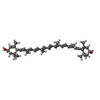 ChemComp-LUT: 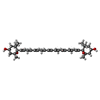 ChemComp-XAT:  ChemComp-LHG: 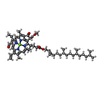 ChemComp-CHL: 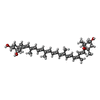 ChemComp-NEX:  ChemComp-FE2:  ChemComp-CL:  ChemComp-PHO:  ChemComp-BCR:  ChemComp-SQD: 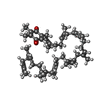 ChemComp-PL9:  ChemComp-LMG: 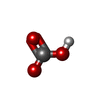 ChemComp-BCT:  ChemComp-DGD:  ChemComp-HEM: |
| Source |
|
 Keywords Keywords |  PHOTOSYNTHESIS / PHOTOSYNTHESIS /  Photosystem II / C2S2M2N2-type PSII-LHCII Photosystem II / C2S2M2N2-type PSII-LHCII |
 Movie
Movie Controller
Controller Structure viewers
Structure viewers About Yorodumi Papers
About Yorodumi Papers






